Do you want to start a scalable Amazon business without the hassle of creating your own brand? Selling wholesale can help you achieve that.
Amazon wholesale is a business model where you purchase products in bulk directly from manufacturers or distributors and resell them on Amazon's platform for a profit.
With the wholesale business model, you can access a wide range of products at competitive prices, streamline your supply chain, and reduce costs associated with storing inventory. This makes it an attractive option for sellers who want to start a scalable Amazon business without investing the time and resources required to create a brand from scratch.
Follow this guide to learn the basics of starting an Amazon wholesale business.
The Wholesale Supply Chain
As a wholesaler on Amazon, you act as the intermediary between the manufacturer (or distributor) and the end user. You’re buying goods at a low price and then selling them at a higher price. This business model can be a profitable venture for entrepreneurs looking to expand their online presence and reach a wider audience.

Is Amazon Wholesale Still Worth It in 2023?
Amazon wholesale is still a good business to start in 2023 because, despite an increase in the number of Amazon sellers, the potential customer base on Amazon also continues to grow.
Here’s the growth of Prime users in the United States:

The growth of the number of Amazon Prime users comes with the growth of Prime Day sales.
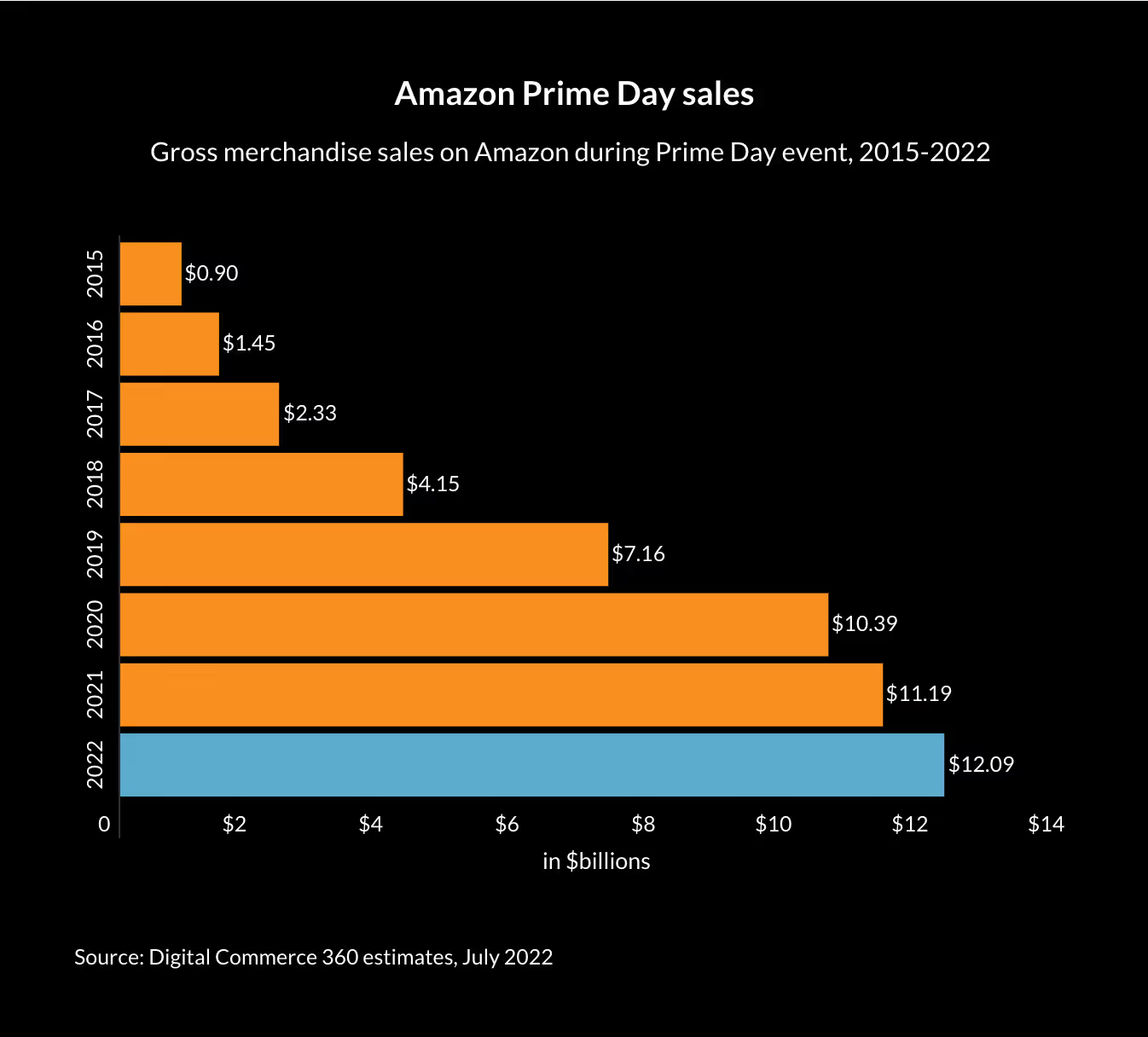
Here’s the table of the Prime Day sales growth since 2015:
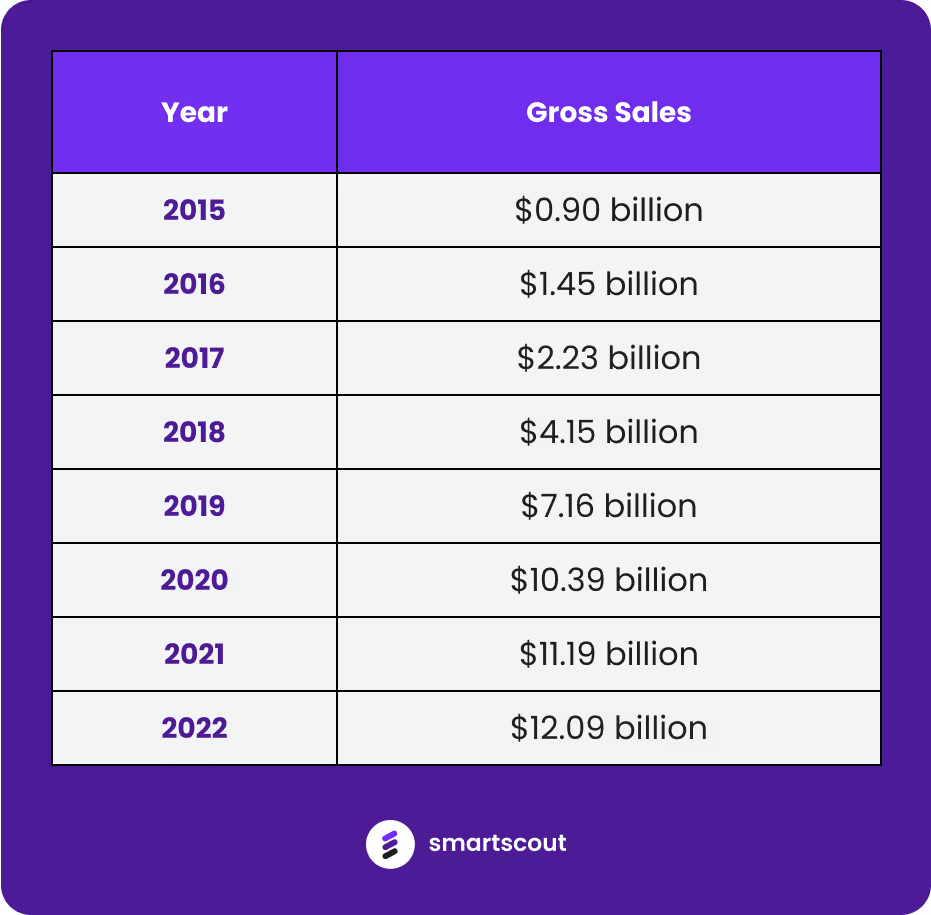
Source: Digital Commerce 360
All the data above shows that Amazon’s revenue continues to grow, so there is still plenty of room for new sellers to get started.
Wholesaling Versus Other Amazon Business Models
- Retail Arbitrage: Retail arbitrage and wholesaling sellers both buy products at a discounted price and resell them at a higher price. But unlike wholesalers who buy products from manufacturers or distributors, retail arbitrage buys products from retail stores.
- Online Arbitrage: From the word “online” itself online arbitrage is just retail arbitrage done online. Instead of buying from physical stores, online arbitrage sellers buy products from online stores.
- Private Label: Wholesale sellers buy products from existing brands. Private label sellers create their own brand. This involves working with a manufacturer to develop and produce the products, giving you more control over quality and pricing. While this can lead to higher profit margins, it also requires a significant investment in time, resources, and marketing.
Advantages of Amazon Wholesale Over Arbitrage
- Bulk Discounts: Buying in bulk results in a higher discount, which then results in higher profit margins.
- Time Efficiency: Unlike arbitrage where you need to search for deals constantly, wholesaling can be more time-efficient as it involves purchasing products in bulk from a single supplier. This means you can spend less time searching for deals and more time focusing on other aspects of your business, such as hunting for more products to sell.
- Consistent Supplier Relationships: Wholesalers on Amazon work directly with manufacturers or established distributors, allowing for the development of long-term and reliable supplier relationships. This can lead to more consistent product quality and availability.
- Greater Control Over Inventory: Wholesalers have greater control over their inventory levels, as they are buying products in bulk. This means they are less reliant on external factors, such as price fluctuations and supply shortages.
- Lower Competition for Products: Unlike arbitrage, which involves competing with other sellers for limited inventory, wholesale sellers can acquire products that are less readily available to the general public. This can lead to less competition and a greater chance of securing sales.
- Scalability: Wholesale sellers buy in large quantities, allowing them to take advantage of economies of scale and negotiate better pricing and terms with their suppliers. This can lead to increased profit margins and the ability to offer competitive pricing to customers. Also, having a reliable supply of products can help sellers avoid stockouts and fulfill orders quickly, which can lead to higher customer satisfaction and repeat business.
Advantages of Amazon Wholesale Over Private Label
- Lower Startup Costs: With private label, you need to invest in product development, branding, and manufacturing, whereas, in wholesale, you purchase existing products in bulk at a discounted price. This can make it more affordable to get started in wholesaling, especially for new entrepreneurs.
- Faster Time-to-Market: In Amazon wholesale, you're selling established products from existing brands. This means you can start selling more quickly than with a private label business, which involves creating, developing, and launching your own products. This faster time-to-market enables you to generate revenue more quickly and start building your business sooner.
- Predictable Demand: Since you're selling products that are proven to sell from established brands in Amazon wholesale, you can benefit from the existing demand for those products. This predictability can make inventory management and sales forecasting more manageable than with private label.
- Lower Risk of Intellectual Property Issues: In a private label, there's a risk of inadvertently infringing on another company's intellectual property rights, such as patents, trademarks, or copyrights, which can lead to legal disputes and costly settlements. With Amazon wholesale, you're selling products from established brands that have already addressed these issues, reducing the risk of intellectual property infringements.
The Simplified Roadmap to Becoming an Amazon Wholesale Seller

Choosing the Right Account Type
Amazon offers two types of seller accounts: Individual and Professional.
The Individual plan, which costs $0.99 for each item you sell, is best for sellers who plan to sell fewer than 40 items per month. The Professional plan, which costs $39.99 per month is best for those who plan to sell more than 40 items per month or want access to advanced selling tools.
Since you'll likely be dealing with a high volume of sales as a wholesaler, the Professional plan is the best plan for you.
Here’s an overview:
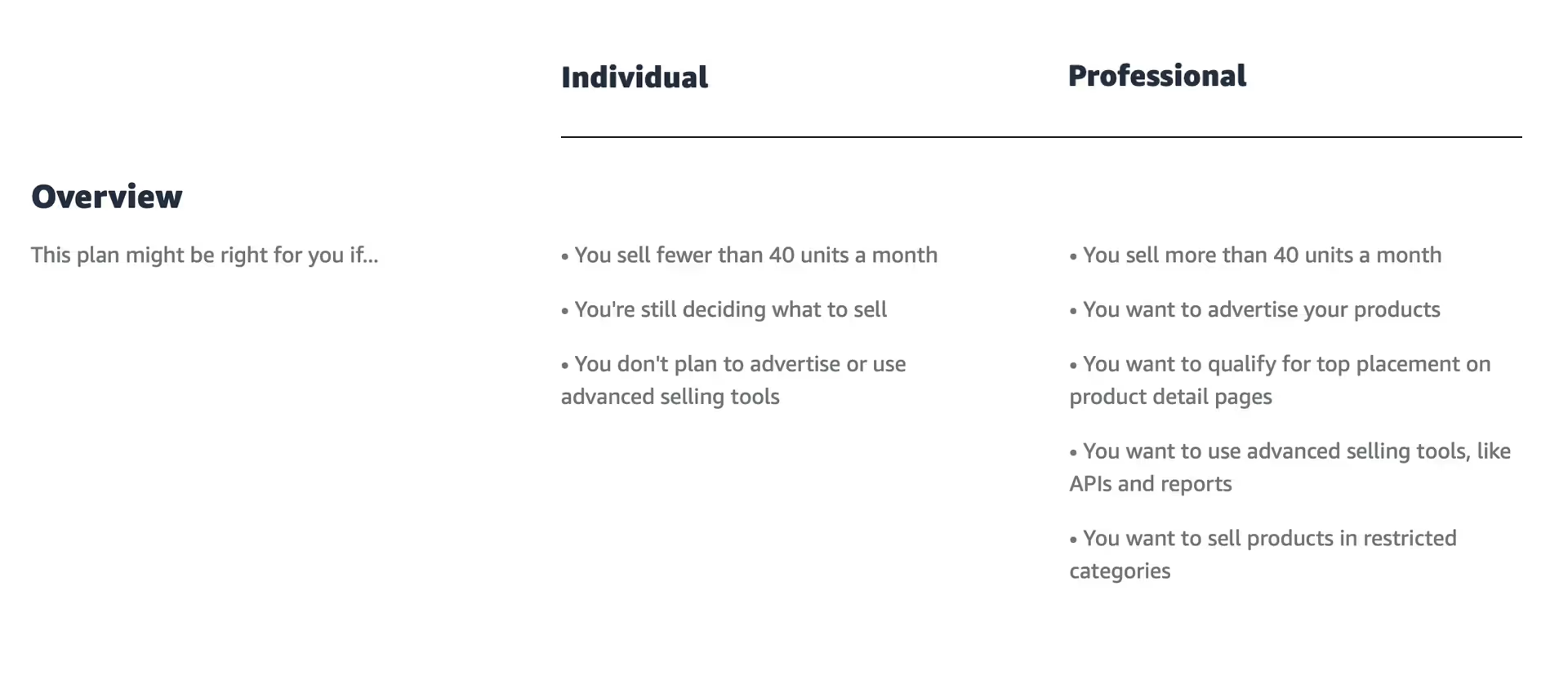
Further Reading:
Professional vs Individual: A Beginner's Guide to Amazon Seller Plans
Creating an Amazon Seller Account
Here Are the Steps To Set Up Your Amazon Seller Account.
- Visit the Amazon Seller Central website and click on "Sign Up."
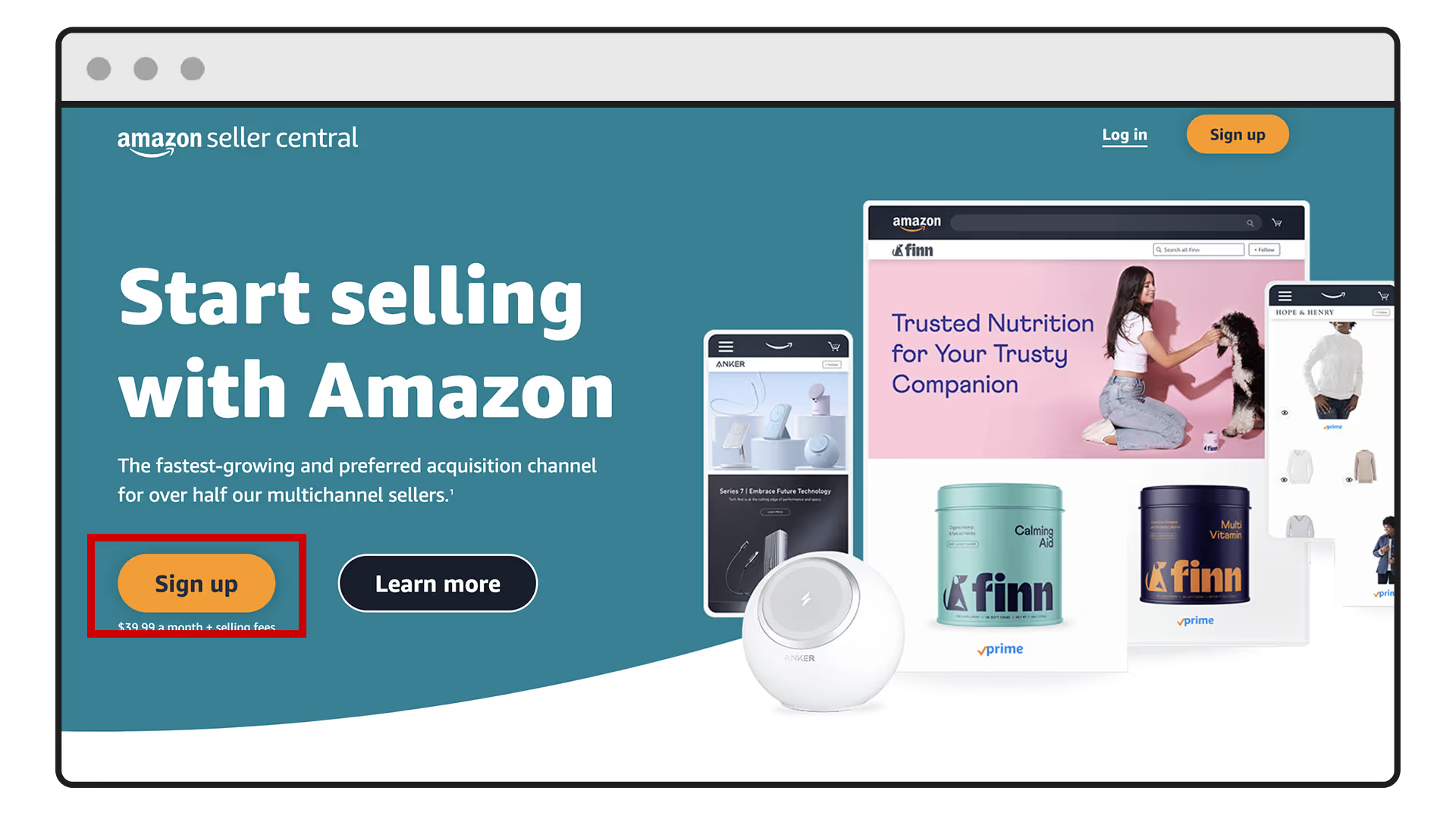
- Sign in with your existing Amazon account or create a new one.
- Fill in the details.
- Choose your plan (Professional).
- Enter your tax identity information.
- Set up your payment method, and voilà! You now have an Amazon seller account.
Permits and Licenses
Before diving headfirst into the wholesale pool, make sure you have the right gear — meaning permits and licenses.
Here's what you'll need:
1. Reseller's permit. A reseller's permit (also known as a sales tax permit) allows you to purchase goods for resale without paying sales tax. Suppliers often require a reseller's permit before they'll do business with you, so don't skip this step. The process varies by state, so be sure to check your state's requirements.
2. Business license. Depending on your state and local regulations, you may need a business license to operate your Amazon wholesale business. Think of it as your business's ticket to the big leagues. Check with your local government office to determine what's required in your area.
3. Tax ID number. You'll need a tax ID number (also known as an Employer Identification Number or EIN) to file taxes and open a business bank account. It's like your business's Social Security number — unique and essential. You can obtain one for free from the IRS by applying online.
Understanding Amazon Fees and Expenses
Amazon charges various fees for selling on their platform. Here's a breakdown of the main fees:
- Subscription fees. For Professional sellers, Amazon charges a monthly subscription fee of $39.99. Think of it as a small price to pay for the chance to make some serious dough.
- Referral fees. Amazon charges referral fees as a percentage of the item's sale price, including shipping and gift wrap charges. These fees vary by category, typically ranging from 8% to 15%.
- Fulfillment fees. Amazon FBA fees refer to the charges that Amazon imposes on sellers who use the Fulfillment by Amazon (FBA) service. With FBA, Amazon stores sellers' products in their fulfillment centers, picks, packs, and ships orders on their behalf, and handles customer service.
The FBA fees vary based on the size and weight of the product, as well as the time it takes to store and fulfill orders. These fees include storage fees, which are calculated based on the amount of space the product occupies in the fulfillment center, and fulfillment fees, which are charged per unit and cover picking, packing, and shipping.
You can use SmartScout’s FBA Calculator to determine a product’s net profit after all the fees.
How To Find Amazon Wholesale Products
There are several methods for finding wholesale products to sell. And there’s no one right way to do it. When you’re in the game for a long time, you’ll discover nuances in product hunting and develop your own method.
Here are some general tips when finding products for your wholesale business:
- Avoid Amazon like a plague
- Avoid selling private label products
- Avoid products with the brand as one of the sellers
- Sell products that are proven to sell. (BSR below 40,000)
- Look for established small-to-medium brands
- Check your potential share of units sold per month
- Check price history
Methods To Find Products for Wholesaling
Method #1 Amazon to Wholesale: The Category Filtering Method
One way to hunt for products on Amazon is through category filtering.
Category filtering is where you dive deep into categories and subcategories to find profitable products.
In a nutshell, here’s what the process looks like:
Step 1. Go to Amazon and choose a category you are interested in selling to.
Step 2. Then choose a category.
Suppose you want to find products under the Pet Supplies category.
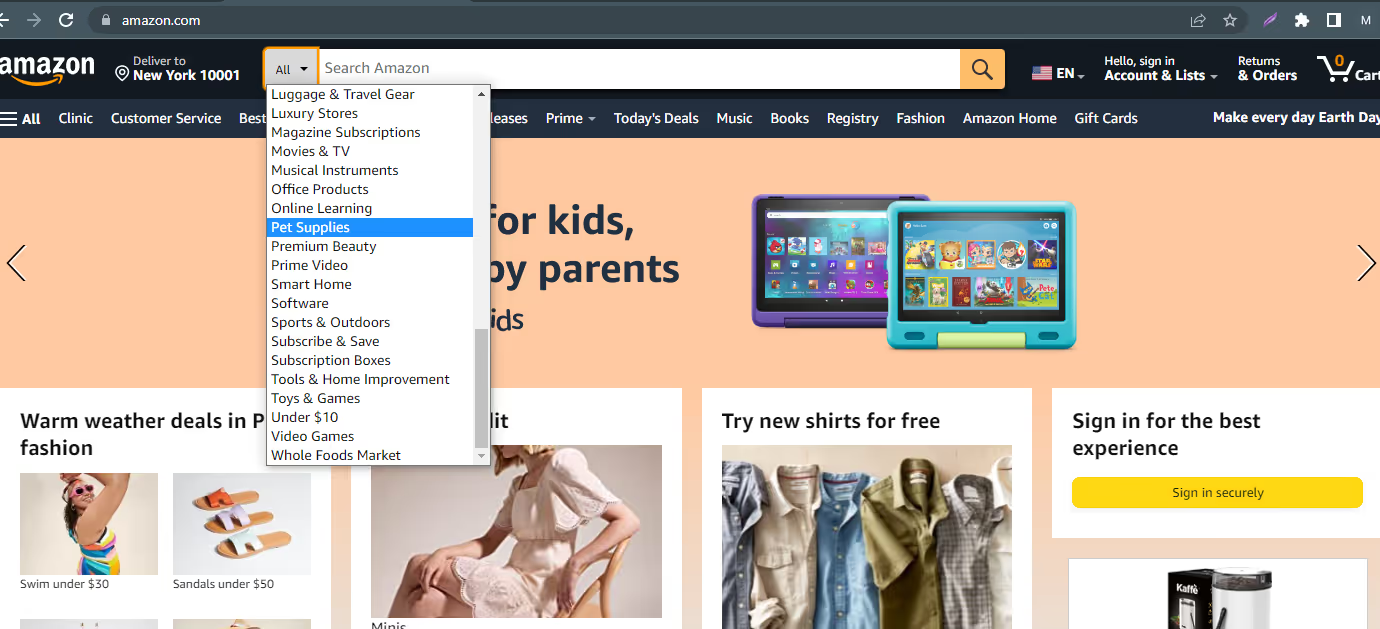
Step 3. Click “Search,” and you will see subcategories under the Pet Supplies category.
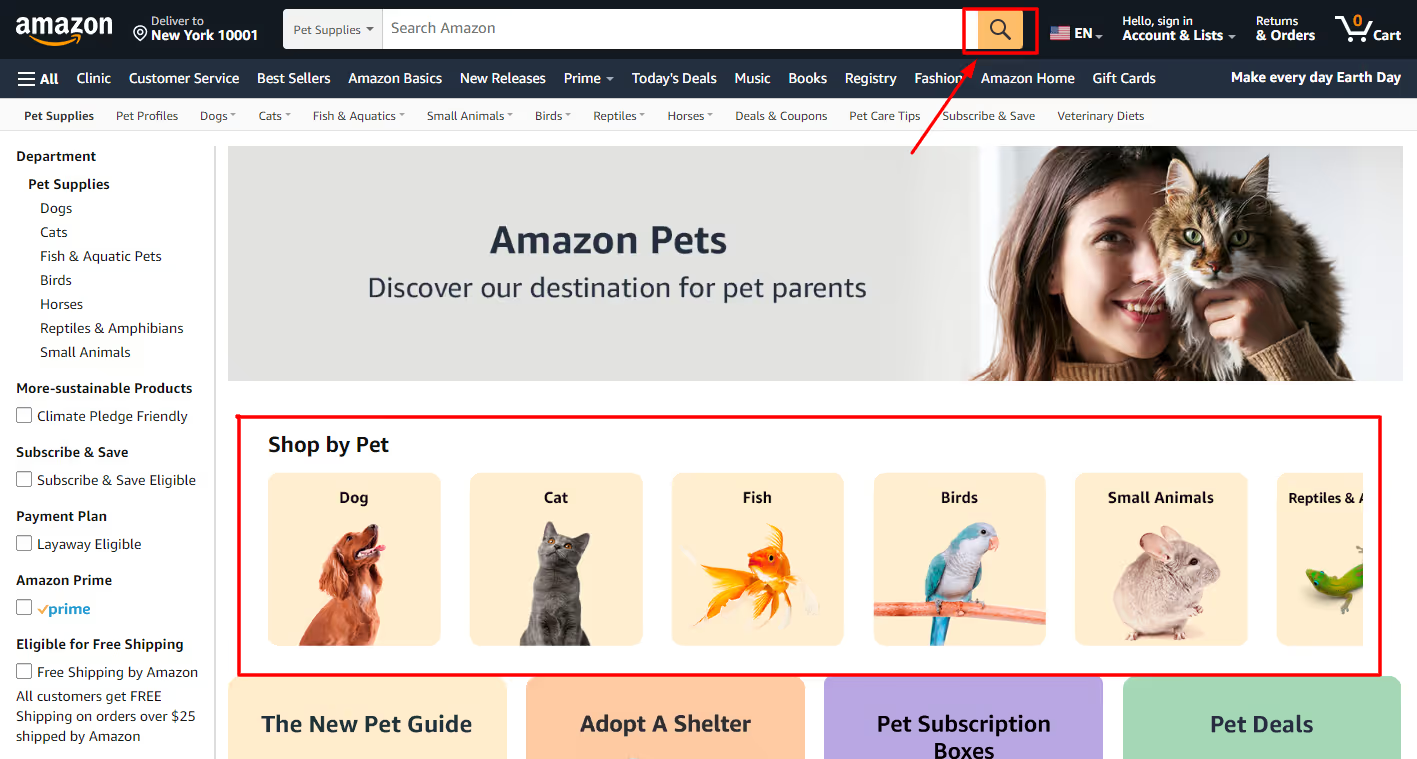
Step 4. Choose a subcategory. (Ex. “Dogs”)

And then another subcategory within your chosen category. (Ex. “Toys”)
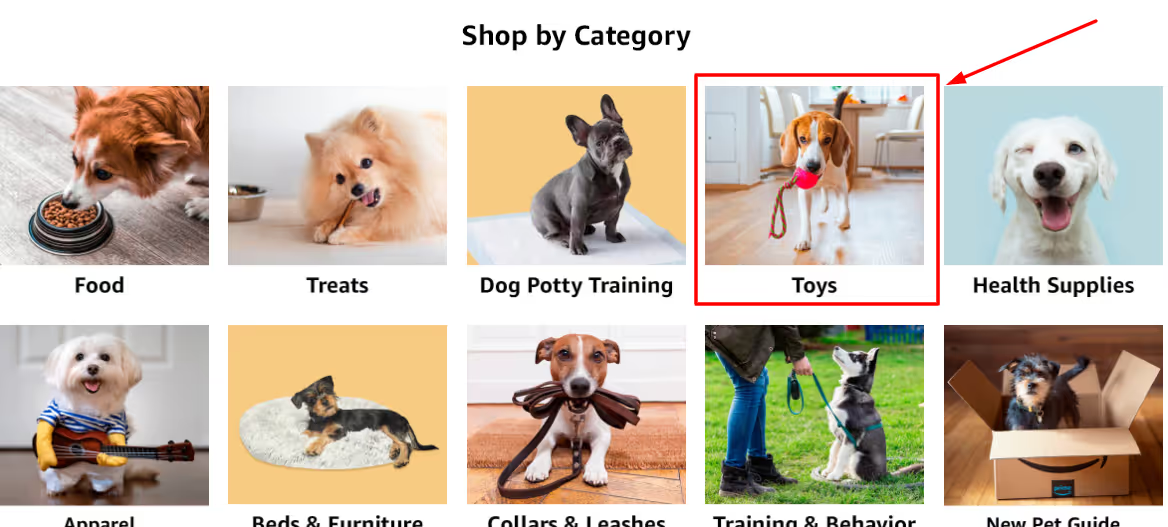
Step 5. Set your filters.
- Customer reviews (4 Stars +)
- Price ($15 - $20 & higher)
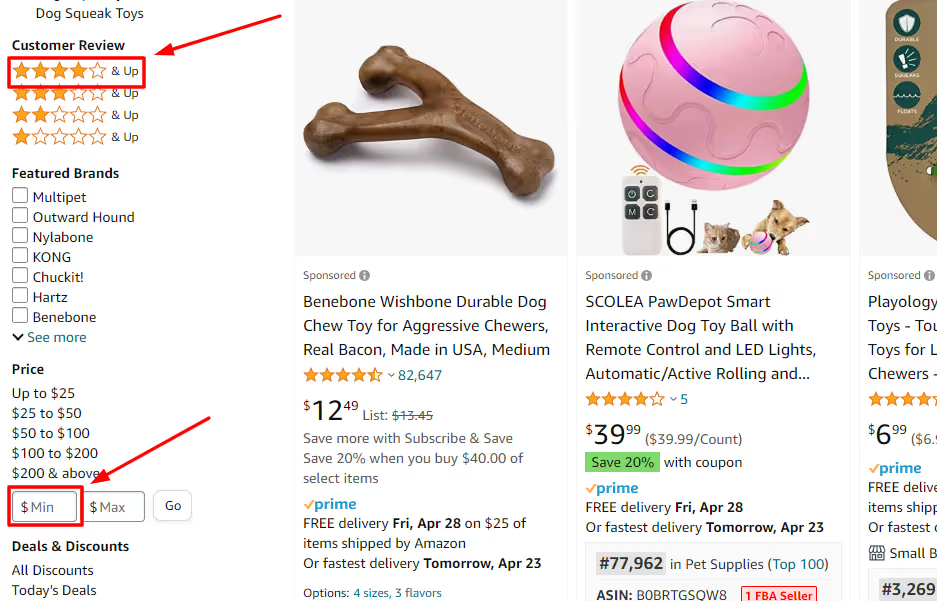
Step 4. Start exploring for product opportunities.
Here’s a demonstration of The Category Filtering Method from Larry Lubarsky:
Method #2 Use a Product Research Tool
If you have enough budget, you can also use Amazon seller tools such as SmartScout to make product hunting easier and faster.
For example, you can perform the Category Filtering Method faster using the Subcategories tool. SmartScout’s Subcategories tool shares the same browsability feature with Amazon, helping you to easily zoom in on your chosen subcategory and filter out products that you don’t want to see.
Let’s perform the same exact process from Method #1 using the Subcategories tool.
Step 1. Login to your SmartScout account.
Step 2. Click “Subcategories” and then choose a subcategory (ex. Pet Supplies).
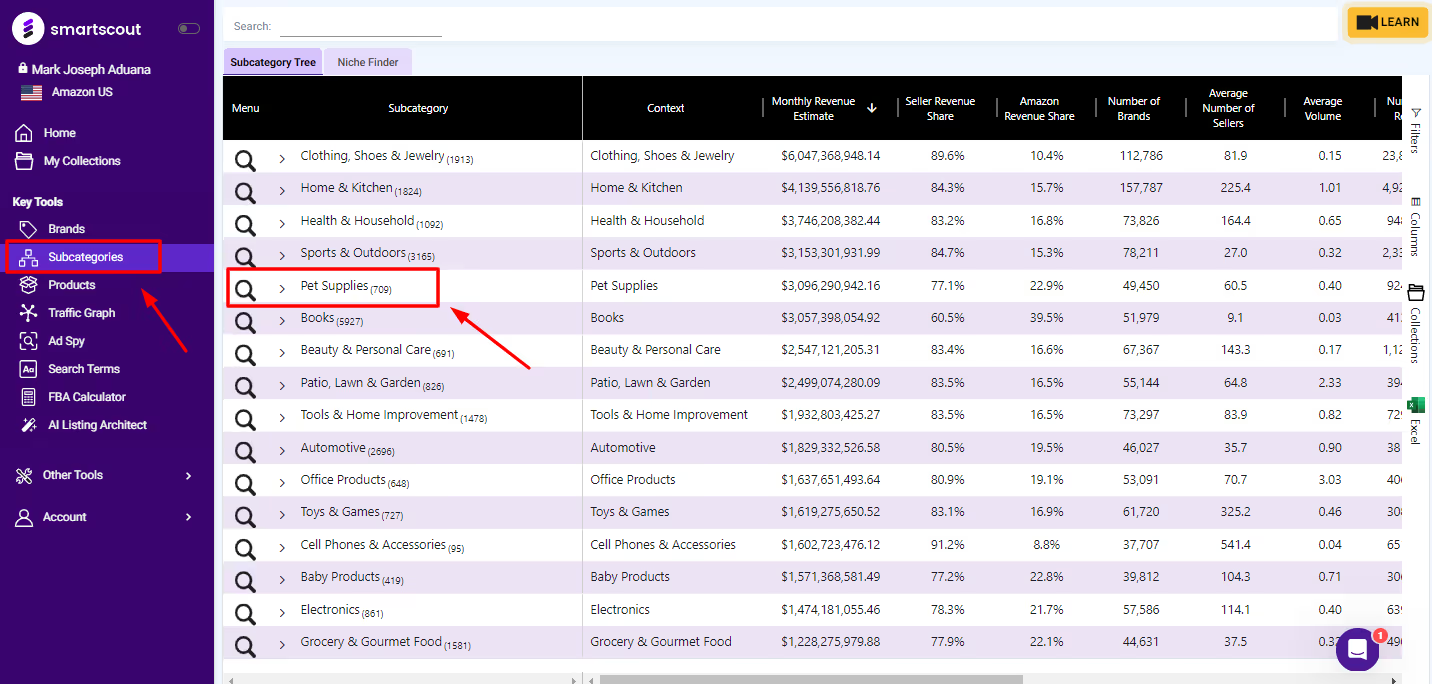
Step 3. Then click a subcategory (ex. Dogs) and another subcategory (ex. “Toys”).
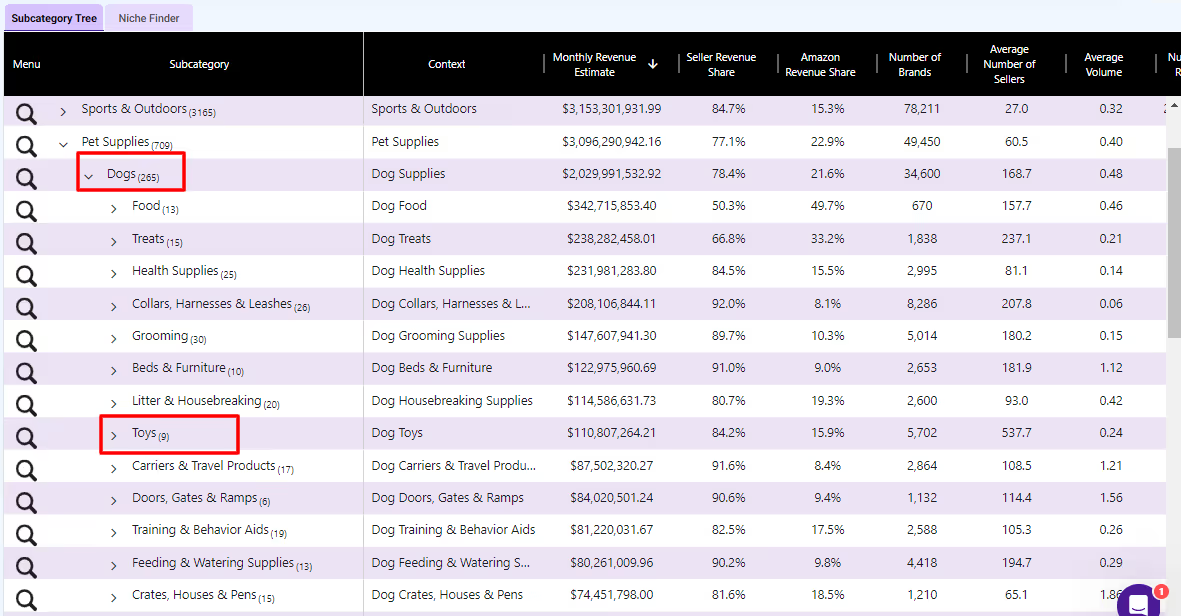
Step 4. After that, click the “magnifying icon” and then “Products.”
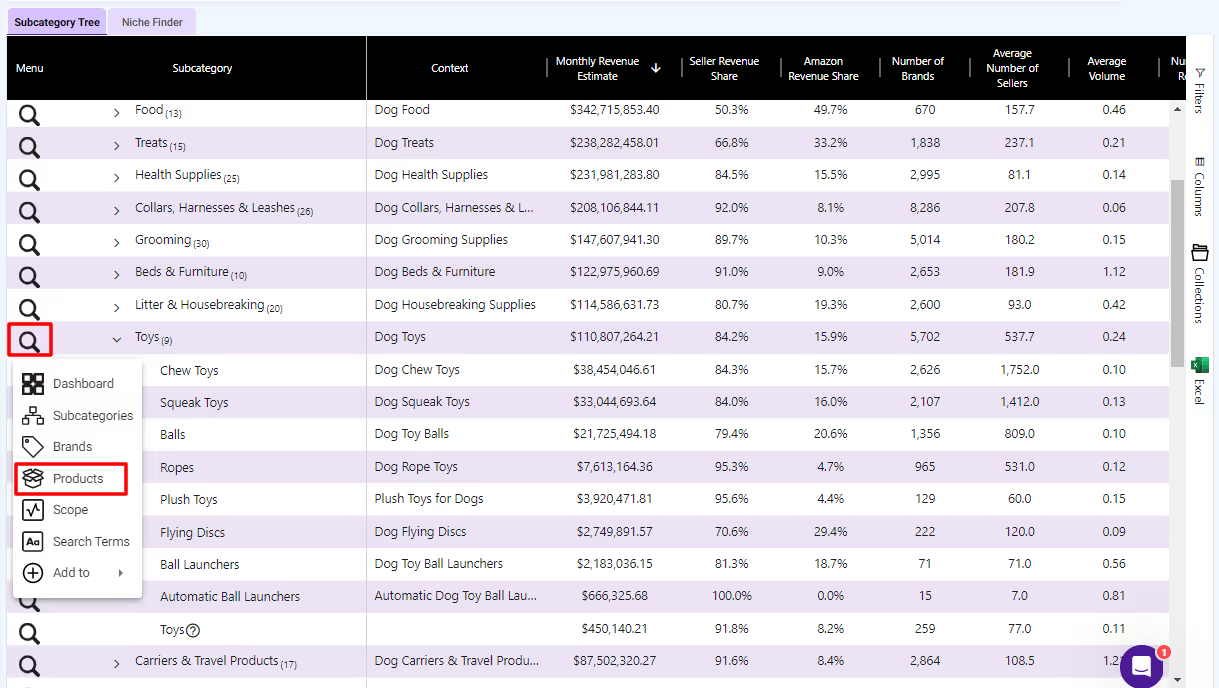
And you will see all the products inside the Toys subcategory.
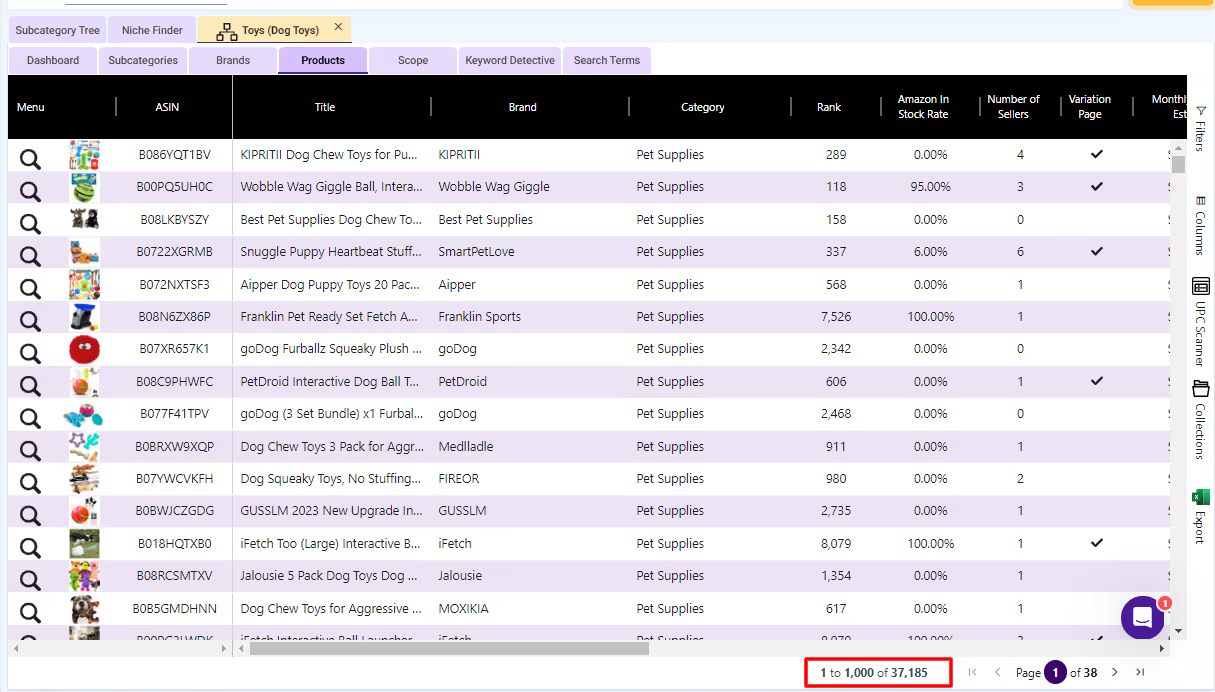
Step 5. Set your desired criteria to only show products that you want to see.
Suppose we set the criteria below:
- Criteria #1: Buy Box Price = $15 minimum
- Criteria #2: Review rating = 4 minimum
- Criteria #3: Amazon In Stock Rate = 0 maximum (to eliminate products with Amazon as one of the sellers)
- Criteria #4: Number of sellers = 3 minimum (to eliminate Private Label products)

After setting the filters, we narrowed our list from 37,185 to 1,173.

You can further narrow your list down by setting more filters. Let’s say we set the minimum BSR to 40,000 and also set the Variation pages to “No” to remove products with variations.
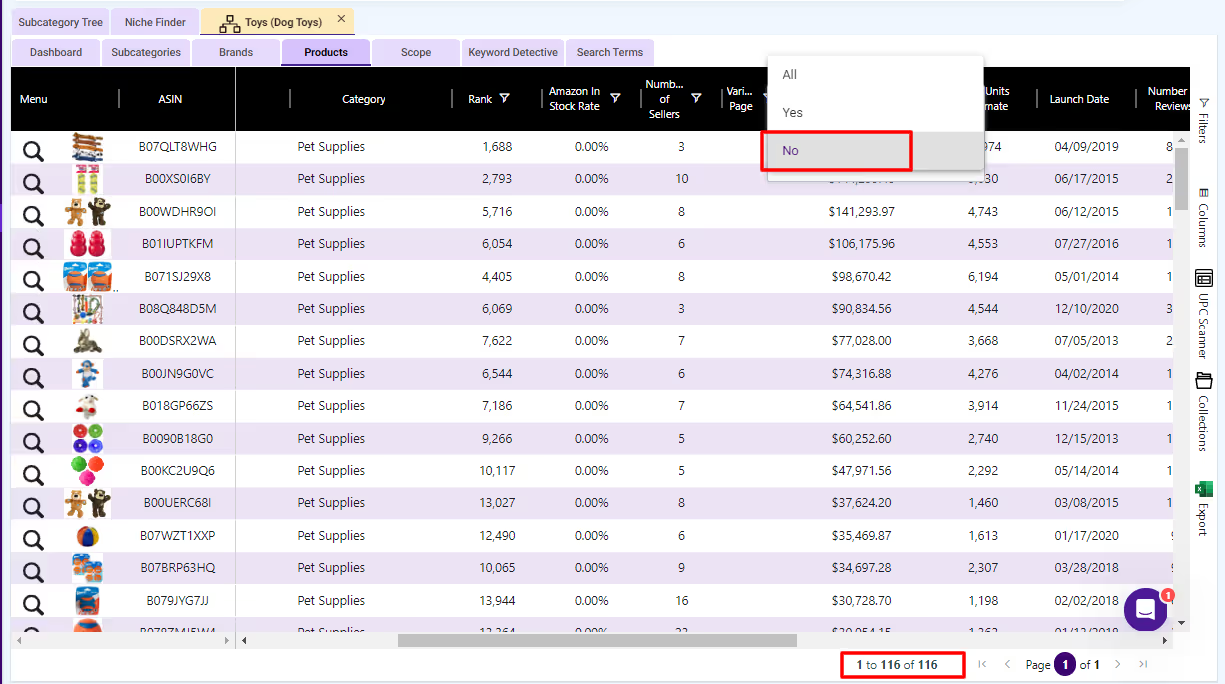
As you can see, we narrowed down our options to 116 potential products to sell. You can now go through each product and run them onto your checklist for profitable products hunting.
These include:
- Confirming that the brand owner is not one of the sellers
- Checking the price history
- Calculating net profits using an FBA Calculator
Bonus Method:
Here’s another way to find wholesale products to sell on Amazon using SmartScout:
Method #3 Wholesale to Amazon
Another way to find profitable products for a wholesale business model is by opening an account with wholesale suppliers and asking for a master list of their wholesale catalog.
In general, here are the steps to find profitable products using this method.
- Find Potential Wholesale Suppliers
- Open an Account With Wholesale Suppliers
- Request a Master List of Their Wholesale Catalog
- Evaluate the Products To Determine Which Ones Meet Your Desired Criteria
Here’s Larry Lubarksy again finding 10 -50 potential products from a Brand’s catalog:
TIP: Use SmartScout’s UPC Scanner tool to scan thousands of products and determine which ones give the highest ROI.
Finding and Approaching Suppliers
Here are some ways to find wholesale suppliers:
1. Attending Trade Shows
Trade shows provide a unique opportunity to meet potential suppliers in person, learn about their products, and network with industry professionals. Plan your visit by researching the exhibitors and preparing a list of suppliers you'd like to meet. If you can't attend in person, many trade shows provide a list of exhibitors on their websites, allowing you to research and contact suppliers directly.
2. Reverse Sourcing with SmartScout
Reverse sourcing involves analyzing competitors' listings on Amazon to identify their suppliers. Tools such as SmartScout simplify this process by providing valuable data on sellers, products, and brands. Use SmartScout to identify trends, find popular products, and uncover suppliers used by successful sellers.
3. Local Distribution Advantages
Sourcing from local distributors offers several benefits, including faster shipping times, lower shipping costs, better quality control, and stronger personal relationships. Additionally, working with local suppliers supports your local economy and small businesses.
4. Wholesale Forums and Communities: Wholesale Central and SaleHoo
Wholesale forums and communities such as Wholesale Central and SaleHoo offer valuable resources for sellers looking for suppliers. These platforms provide a place for sellers to connect with suppliers, share experiences, and seek recommendations.
Wholesale Central is a comprehensive directory of wholesalers and dropshippers, offering a wide range of products from various industries. The platform also features a forum where sellers can exchange information and advice.
SaleHoo is a popular wholesale directory and community, providing access to over 8,000 suppliers and dropshippers worldwide. The platform offers a forum, market research tools, and customer support to help sellers find and work with reliable suppliers.
5. Supplier Directories
Finding suppliers can feel like searching for a needle in a haystack, but supplier directories can make the process much easier.
Here are a few popular options:
- Alibaba: A global marketplace connecting sellers with suppliers from various industries. It's an excellent resource for finding manufacturers and wholesalers, primarily in Asia.
- Global Sources: A leading B2B marketplace offering a wide range of products from manufacturers and suppliers, mainly in Asia.
- ThomasNet: A directory of North American manufacturers, suppliers, and distributors, with a focus on industrial and commercial products.
Managing Inventory and Order Fulfillment
You've found profitable products and reliable suppliers, but your Amazon wholesale journey is far from over. Now comes the task of managing inventory and order fulfillment.
In this chapter, we'll help you navigate the ins and outs of fulfillment methods, inventory management, and dealing with returns and refunds.
Choosing a Fulfillment Method
Fulfillment by Amazon (FBA) vs. Fulfillment by Merchant (FBM)
When it comes to fulfilling orders, you have two main options: Fulfillment by Amazon (FBA) and Fulfillment by Merchant (FBM). Each has its pros and cons, so let's take a closer look:
Fulfillment by Amazon (FBA): With FBA, Amazon takes care of storage, packing, shipping, and customer service for your orders. This means you can sit back, relax, and let Amazon handle the nitty-gritty details. However, FBA comes with its own set of fees, and you'll need to comply with Amazon's strict inventory requirements.
Fulfillment by Merchant (FBM): FBM puts you in the driver's seat, allowing you to manage your own inventory, shipping, and customer service. This can lead to lower fees and more control over your business, but it also means increased responsibility and potential time constraints.
Note: FBA products win the BuyBox more than the FBM products. Amazon prioritizes FBA. Plus, your products become eligible for Amazon Prime when you use FBA, helping you increase your sales and visibility. Prime members tend to prefer products that are eligible for free two-day shipping, so having this badge on your listings can give you an edge over competitors.
Inventory Management Best Practices
Maintaining optimal inventory levels is crucial for ensuring smooth order fulfillment and happy customers. Follow these best practices to keep your inventory management game strong:
- Keeping track of stock levels: Monitor your inventory levels closely to avoid stockouts and overstocking. Use inventory management software or create a spreadsheet to track your stock levels, and make sure to update it regularly
- Planning for seasonality and fluctuations in demand: Seasonal trends, holidays, and other factors can impact product demand, so plan your inventory accordingly. Anticipate these fluctuations and adjust your inventory levels to meet changing demand and avoid stockouts or excess inventory
Dealing With Returns and Refunds
Returns and refunds are inevitable in the world of eCommerce. Here's how to handle them like a pro:
1. Amazon's Return Policy
As an Amazon seller, you're required to comply with Amazon's return policy, which generally allows customers to return items within 30 days of receipt. Familiarize yourself with this policy and make sure your business practices align with its requirements.
2. Handling Returns Efficiently
To minimize the impact of returns on your business, establish an efficient return process. This includes:
- Inspecting Returned Items: Check returned products for damage or defects and determine if they can be resold
- Processing Refunds Promptly: Refund customers promptly to maintain a positive reputation and keep them coming back for more
- Analyzing Return Data: Keep track of return reasons to identify patterns and address potential issues with your products or suppliers
Final Thoughts
Starting an Amazon FBA wholesale business can be a lucrative opportunity for those who are willing to put in the effort and learn the fundamentals of the business. Despite the increasing competition, the growth of Amazon and e-commerce in general presents a promising market for wholesalers.
Additionally, tools such as SmartScout can help in finding profitable products with ease. By investing time and effort, anyone can thrive in the world of Amazon wholesale. The key is to stay focused, determined, and willing to adapt to changes in the industry. With these traits, success in Amazon wholesaling is possible.










